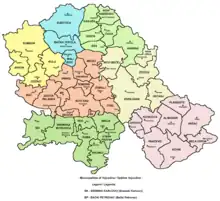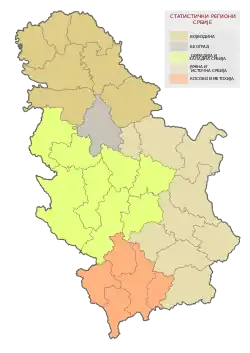Mali Iđoš
Mali Iđoš (Serbian Cyrillic: Мали Иђош, pronounced [mâːliː îdʑoʃ]; Hungarian: Kishegyes, pronounced [ˈkiʃhɛɟɛʃ]) is a village and municipality located in the North Bačka District of the autonomous province Vojvodina, Serbia. The municipality comprises three local communities and has a population of 12,031, of whom 6,486 (53.91%) are ethnic Hungarians, 2,388 are Serbs (19.85%) and 1,956 are Montenegrins (16.26%). Mali Iđoš village has a population of 4,830.
Mali Iđoš
| |
|---|---|
Village and municipality | |
| Mali Iđoš | |
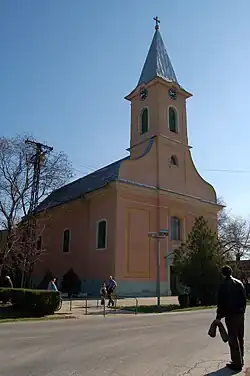 Church of Saint Anne in Mali Iđoš | |
 Coat of arms | |
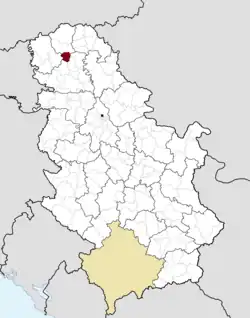 Location of the municipality of Mali Iđoš within Serbia | |
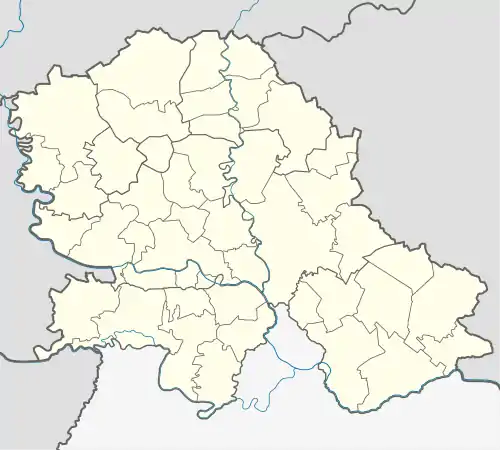 Mali Iđoš  Mali Iđoš  Mali Iđoš | |
| Coordinates: 45°42′25″N 19°39′52″E | |
| Country | |
| Province | |
| District | North Bačka |
| Settlements | 3 |
| Government | |
| • Mayor | Marko Lazić (SNS) |
| Area | |
| • Municipality | 175 km2 (68 sq mi) |
| Elevation | 88 m (289 ft) |
| Population (2011 census)[2] | |
| • Town | 4,830 |
| • Municipality | 11,926 |
| Time zone | UTC+1 (CET) |
| • Summer (DST) | UTC+2 (CEST) |
| Postal code | 24321 |
| Area code | +381 24 |
| Car plates | SU |
Name
The first part of the name of the village, "mali" ("little" in English), was given in contrast to the village with similar name (Iđoš), which is situated in northern Banat. The etymology goes back to the Hungarian name, 'Kishegyes', consisting of 'kis' (little) and 'hegyes' (mountainy [place]).
Inhabited places
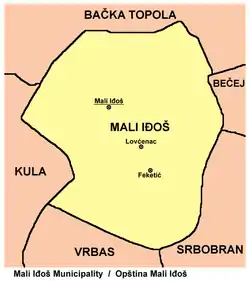
Mali Iđoš municipality includes the following villages:
Demographics
| Year | Pop. | ±% p.a. |
|---|---|---|
| 1948 | 17,683 | — |
| 1953 | 16,767 | −1.06% |
| 1961 | 17,144 | +0.28% |
| 1971 | 15,651 | −0.91% |
| 1981 | 14,975 | −0.44% |
| 1991 | 14,394 | −0.39% |
| 2002 | 13,494 | −0.59% |
| 2011 | 12,031 | −1.27% |
| Source: [3] | ||
According to the 2011 census results, the municipality of Mali Iđoš has a population of 12,031 inhabitants.
Ethnic groups
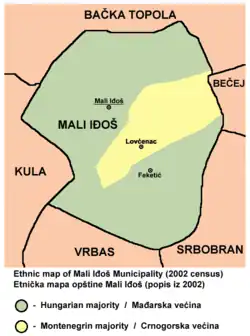
Local communities with a Hungarian majority are Mali Iđoš and Feketić. There is one local community with a Montenegrin majority: Lovćenac.
The ethnic composition of the municipality:[4]
| Ethnic group | Population | Proportion |
|---|---|---|
| Hungarians | 6,486 | 53.91% |
| Serbs | 2,388 | 19.85% |
| Montenegrins | 1,956 | 16.26% |
| Roma | 283 | 2.35% |
| Romanians | 268 | 2.23% |
| Croats | 55 | 0.46% |
| Albanians | 43 | 0.36% |
| Muslims | 33 | 0.27% |
| Rusyns | 30 | 0.25% |
| Yugoslavs | 24 | 0.20% |
| Macedonians | 20 | 0.17% |
| Others | 445 | 3.70% |
| Total | 12,031 |
History
The name of Kishegyes was first mentioned in historical documents in 1476, without naming the shire, when the estates of the Maróthi family in the region of the Tisza river were counted. On 16 February 1462 Matthias Corvinus gave the settlements listed in the document as a present to his mother, Erzsébet Szilágyi. The destruction of the village started in 1514. The riot of György Dózsa required not only material damages, demolitions, driving away of cattle, but also a huge number of human victims. All this was followed by the defeat of Mohács. After the battle, the victor, the general of sultan Suleiman the Magnificent withdrew between the Danube and the Tisza rivers. The institutional Turkish subjection started after the fall of Buda, in 1541. The village became totally destroyed under Turkish occupation in the 16th century. The later Turkish tax assessment registers mention Kishegyes in the nahije of Szabadka with 18 houses to pay taxes in 1580–82 and 1590–91, and 17 in Nagyhegyes in 1580 and 23 houses in 1590. In 1652 the inhabitants of Hegyes paid taxes to Ferenc Wesselényi. It was repopulated in 1769 by 81 Roman Catholic Hungarian families from Békésszentandrás.[5] During the Hungarian Revolution of 1848 in Battle of Hegyes, the Hungarian soldiers gained a victory in Kishegyes on 14 July 1849. The region is extremely well suited for agriculture and the village increased in wealth and population until the 1980s. In the 1990s the local economy was ruined and young people began to emigrate to Hungary. Today the rate of unemployment is appr. 30 percent, and the Agricultural Cooperative and the Commercial Company went bankrupt. After the end of the civil war in Croatia and Bosnia (1995–96) Serbian refugees arrived to Mali Iđoš (Kishegyes). There are no ethnic tensions between native Hungarians and the Serbian refugees.
Sights
The oldest building in Mali Iđoš is the baroque Roman Catholic Church of St. Anne (1788) on the Main Street. There is an old Calvary, the obelisk of the Battle of Hegyes and the ruins of the Pecze Mansion. The natural attractions are the River Krivaja and the imposing loessal walls of the Hills of Telečka.
Notable people
- The Hungarian singer Magdolna Rúzsa grew up in Mali Iđoš. She won Megasztár, Hungary's version of Pop Idol in 2006 and represented Hungary at the Eurovision Song Contest 2007 in Helsinki, Finland.
- Ištvan Dudaš is a former Serbian professional footballer, who currently works as Goalkeeper coach for R.O.C. de Charleroi-Marchienne.[6]
International relations
See also
References
- "Municipalities of Serbia, 2006". Statistical Office of Serbia. Retrieved 2010-11-28.
- "2011 Census of Population, Households and Dwellings in the Republic of Serbia: Comparative Overview of the Number of Population in 1948, 1953, 1961, 1971, 1981, 1991, 2002 and 2011, Data by settlements" (PDF). Statistical Office of Republic Of Serbia, Belgrade. 2014. ISBN 978-86-6161-109-4. Retrieved 2014-06-27.
- "2011 Census of Population, Households and Dwellings in the Republic of Serbia" (PDF). stat.gov.rs. Statistical Office of the Republic of Serbia. Retrieved 19 March 2017.
- "Попис становништва, домаћинстава и станова 2011. у Републици Србији" (PDF). stat.gov.rs. Republički zavod za statistiku. Retrieved 6 April 2019.
- "Official Presentation of Mali Iđoš". Kishegyes.rs. Retrieved 27 August 2017.
- "Noyau 2008-2009: Istvan Dudas (T3)". Archived from the original on 2011-08-23. Retrieved 2011-03-27.
- "Братски градови и општине". maliidjos.rs (in Serbian). Mali Iđoš. Retrieved 2020-01-07.
Other sources
- Slobodan Ćurčić, Broj stanovnika Vojvodine, Novi Sad, 1996. OCLC ocm39963150
External links
- History of Mali Iđoš (in Hungarian)
- Non-official website

